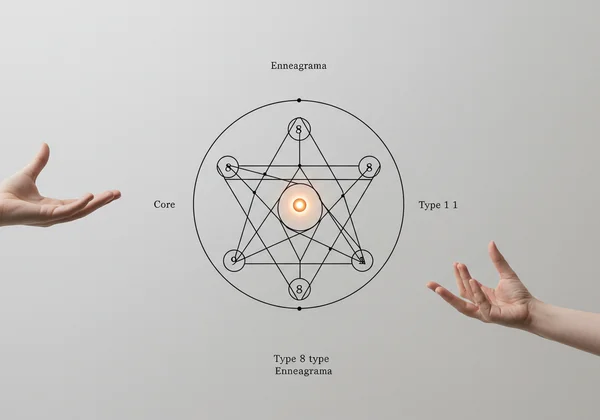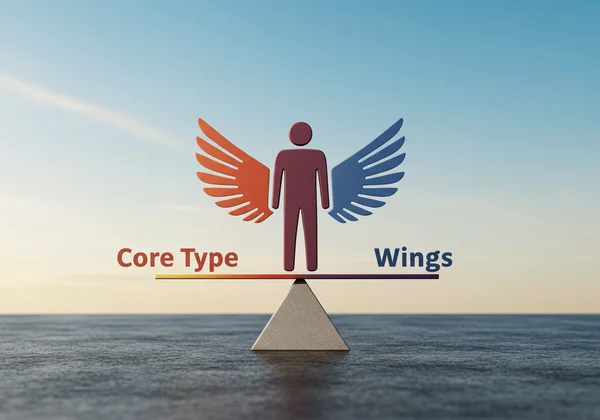Enneagram Wings Explained: An Enneagram Test Guide to Your True Type
Discovering your core Enneagram type is a profound first step on the path of self-discovery. There's a fascinating layer beyond your core Enneagram type that reveals incredible depth and nuance to your personality. Many people find their type but feel something is missing, a specific flavor that isn't fully captured by the core description. This is where Enneagram wings come in. What are Enneagram wings and why do they matter so much for achieving your best self?
Understanding your wings is like switching from a black-and-white photo of yourself to a full-color one. It illuminates the subtle shades and highlights that make you uniquely you. This guide will walk you through what wings are, how they influence you, and how you can start identifying your own. If you're ready to go beyond the basics, you can discover your results and begin this deeper exploration.

What Are Enneagram Wings & Why Do They Matter?
For those passionate about psychology, the concept of Enneagram wings offers a captivating insight into personality dynamics. They are the key to moving beyond stereotypes and seeing the dynamic nature of personality. Simply put, your wings are the two Enneagram types that sit directly on either side of your core type on the Enneagram symbol. For example, if you are a Type 9, your wings are Type 8 and Type 1.

These adjacent types lend some of their characteristics, motivations, and behaviors to your core personality. They don’t change your fundamental type, but they add distinct flavors and resources. Recognizing this influence is crucial because it accounts for the rich diversity we see within each type and helps you understand your own unique complexities.
Understanding the Concept of Enneagram Subtypes
It's helpful to think of wings as one of the most important Enneagram subtypes. While your core type explains your main motivation and fear, subtypes add layers of detail. Wings explain how your core type might express itself in the world. For instance, two people who identify as Type 4, The Individualist, can appear very different depending on their dominant wing.
One might be more flamboyant and assertive (a 3-wing), while the other is more reserved and intellectual (a 5-wing). Neither is more or less of a Type 4; their wings just color their core personality in different ways. This concept is a pillar of nuanced personality analysis.
The Dynamic Influence of Adjacent Enneagram Types
The beauty of the Enneagram lies in its dynamic structure. Your wings represent the adjacent types you can easily access. Think of your core type as your home base and your wings as the neighboring towns you frequently visit. You pick up their local customs and ways of thinking, which then blend with your own.
This influence creates a spectrum of expression for your type. A Type 2 with a 1-wing (2w1) might channel their helpfulness into being more principled and orderly. A Type 2 with a 3-wing (2w3) might be more ambitious and image-conscious in their efforts to connect with others. Understanding this dynamic is key to a complete self-portrait.
How Enneagram Wings Influence Your Core Type
The influence of an Enneagram type with wings is not just a minor detail; it fundamentally shapes your experience. It can affect your career choices, your communication style, and how you handle stress. Recognizing which wing is more active in your life gives you a more precise roadmap for growth and self-acceptance.
Your wings can provide balance to your core type's potential pitfalls or, if you're unaware of them, they can amplify certain challenges. For example, the 1-wing can add a disciplined edge to the easygoing Type 9, helping with procrastination. The journey of self-discovery often involves learning to harness the strengths of both your core type and your wings. For an initial look, a take a free personality test can offer valuable clues.

Exploring Dominant vs. Non-Dominant Wings
While you have two wings, most people find that they lean more heavily on one than the other. This is known as your dominant wing. It's the "flavor" that is most prominent in your personality. It's possible to have balanced wings, drawing equally from both sides, but this is less common.
To identify your dominant wing, you must look closely at your behaviors and motivations. Do the traits of the number on your left or your right resonate more with you? For instance, a Type 7 must ask: do I feel the influence of the assertive and protective Type 8 more, or the disciplined and perfectionistic Type 6? There is no right or wrong answer, only what is true for you.
Real-World Examples of Enneagram Types with Wings
Let’s make this concrete. Consider a Type 5, The Investigator. A 5w4 will blend the 5's desire for knowledge with the 4's creativity and emotional depth, often drawn to more humanistic or artistic fields. Their personality traits reflect a person who is both intellectual and iconoclastic.
In contrast, a 5w6 combines the 5's analytical mind with the 6's need for security and loyalty. This individual is often a troubleshooter, excelling at creating systems and predicting problems. They are more pragmatic and collaborative than their 4-winged counterpart. Seeing these differences highlights how crucial wings are to understanding yourself and others.
Practical Steps for Identifying Your Enneagram Wing
So, how do you go about understanding wings for yourself? It's a process of combining objective information with deep self-inquiry. There isn't a magic button, but there are clear, actionable steps you can take to uncover this essential piece of your personality puzzle.
The goal is not to force yourself into a box but to find the description that feels most authentic. This journey is one of the most rewarding parts of working with the Enneagram, as it requires honesty and curiosity. It's a step toward true self-knowledge.
Beyond the Test: Self-Observation and Reflection
While a test is an excellent starting point, the most critical tool for identifying your wing is self-awareness. Pay attention to your patterns. When you are at your best, which set of positive traits do you exhibit? When you are stressed, which negative tendencies emerge? Keep a journal and note your reactions in different situations.
Consider your core fears and desires. Does the influence of one adjacent type feel more aligned with your lifelong motivations? This process of reflection is where the Enneagram transforms from a mere personality test into a powerful tool for personal growth.

Utilizing Enneagram Test Results for Wing Clues
A high-quality Enneagram test can provide invaluable clues about your dominant wing. While a free test will give you your core type, a comprehensive analysis can show which of the adjacent types you scored highest on after your core type. This gives you a data-driven starting point for your self-exploration.
The results from a well-designed online enneagram test can act as a mirror, reflecting patterns you may not have noticed. Use these results not as a final verdict, but as a guide for your reflection. Our free Enneagram test is designed to provide these kinds of insightful clues.
The Benefits of Understanding Your Enneagram Wing
Embracing the knowledge of your wing is more than just a fun psychological fact. It has tangible benefits that can improve your life, from your inner world to your external relationships. It provides a more complete and compassionate understanding of why you do what you do.
This deeper level of knowledge empowers you to make more conscious choices. It helps you navigate your personal and professional life with greater skill and confidence, leveraging your full range of strengths.
Enhanced Self-Awareness and Growth Paths
Knowing your wing illuminates your full personality structure, including your unique strengths, hidden challenges, and specific growth paths. For example, a Type 1 with a 2-wing (1w2) can learn to soften their inner critic by leaning into the compassionate and people-focused energy of their wing.
This enhanced self-awareness prevents you from getting stuck in the limitations of your core type. It shows you the resources you already have available within yourself to become a more balanced and integrated person.
Improving Relationships and Communication
When you understand your own nuanced personality, you are better equipped to understand the complexity of others. Recognizing how wings operate can transform your interpersonal dynamics. You'll stop seeing a "Type 8" and start seeing a person who might be an 8w7 (more optimistic and adventurous) or an 8w9 (more patient and receptive).

This insight fosters empathy and improves communication. It helps you appreciate the subtle differences in people, leading to more effective collaboration in the workplace and deeper connections in your personal life. Taking an accurate enneagram test is a great first step toward this understanding.
Your Next Step Towards Comprehensive Self-Discovery
Understanding your Enneagram wings is an essential step toward unlocking a complete and dynamic view of your personality. It moves you beyond a simple label and into a deeper appreciation for the unique blend of traits that make you who you are. Your core type is your story's main plot, but your wing is the compelling subplot that makes it truly interesting.
This knowledge provides a clearer path for growth, helps you navigate relationships with greater wisdom, and ultimately fosters a more compassionate relationship with yourself. Your journey of self-discovery is ongoing, and every layer you uncover brings you closer to your full potential.
Ready to explore your unique personality profile? Take our free test today and start the journey to realizing your capabilities.
Frequently Asked Questions About Enneagram Wings
How do I find my Enneagram wing?
Finding your wing involves a two-part process. First, take a reliable test, like our free enneagram test, to identify your core type and get clues about your likely wing. Second, read the descriptions of the two adjacent types and reflect honestly on which one's motivations and behaviors resonate more with you over your lifetime.
Can an Enneagram type have two wings?
While you are influenced by both adjacent numbers, most Enneagram experts agree that individuals have one dominant wing. Think of it as having a major and a minor influence. It's more common to lean significantly toward one wing, though developing your less-dominant wing is a path for personal growth.
What is the difference between Enneagram core type and wing?
Your core type represents your fundamental worldview, including your primary motivation and core fear. It's the "why" behind your actions. A wing doesn't change this core; it only adds a "flavor" or style to it. The wing is the "how" you go about expressing your core type's drives.
What are the 9 types of Enneagram?
The nine Enneagram types are: Type 1 (The Reformer), Type 2 (The Helper), Type 3 (The Achiever), Type 4 (The Individualist), Type 5 (The Investigator), Type 6 (The Loyalist), Type 7 (The Enthusiast), Type 8 (The Challenger), and Type 9 (The Peacemaker). You can find your type on our website.
How accurate is the Enneagram test for wings?
A well-constructed accurate enneagram test can be very effective at pointing you toward your dominant wing. Our test analyzes your responses to identify not just your core type but also the strength of influence from other types. However, we always recommend using the results as a starting point for deeper self-reflection to confirm your wing.